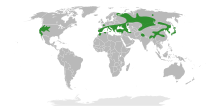
Back عود الصليب Arabic عود الصليب ARZ Pion Azerbaijani پیون AZB Panavėjė BAT-SMG Півоня Byelorussian Божур Bulgarian ཤིང་པད་མ། Tibetan Pivoena Breton Božuri BS
| Peony | |
|---|---|

| |
| Paeonia suffruticosa | |
| Scientific classification | |
| Kingdom: | Plantae |
| Clade: | Tracheophytes |
| Clade: | Angiosperms |
| Clade: | Eudicots |
| Order: | Saxifragales |
| Family: | Paeoniaceae Raf.[1] |
| Genus: | Paeonia L. |
| Type species | |
| Paeonia officinalis L.
| |
| Sections | |
and for lower taxa see text | |

| |
| The range of Paeonia. | |
The peony or paeony (/ˈpiːəni/)[2][3] is any flowering plant in the genus Paeonia,[4] the only genus in the family Paeoniaceae. Peonies are native to Asia, Europe, and Western North America. Scientists differ on the number of species that can be distinguished, ranging from 25 to 40,[5][6] although the current consensus describes 33 known species.[7] The relationships between the species need to be further clarified.[8]
Most are herbaceous perennial plants 0.25–1 metre (1–3 ft) tall, but some are woody shrubs 0.25–3.5 metres (1–11 ft) tall. They have compound, deeply lobed leaves and large, often fragrant flowers, in colors ranging from purple and pink to red, white or yellow, in late spring and early summer. The flowers have a short blooming season, usually only 7–10 days.
Peonies are popular garden plants in temperate regions. Herbaceous peonies are also sold as cut flowers on a large scale, although generally only available in late spring and early summer.[9]
- ^ Angiosperm Phylogeny Group (2009). "An update of the Angiosperm Phylogeny Group classification for the orders and families of flowering plants: APG II" (PDF). Botanical Journal of the Linnean Society. 161 (2): 105–121. doi:10.1111/j.1095-8339.2009.00996.x. hdl:10654/18083. Retrieved 6 July 2013.
- ^ The Concise Oxford English Dictionary (12th ed., 2011) lists paeony as a variant spelling of peony.
- ^ "paeony". Dictionary.com Unabridged (Online). n.d.
- ^ "Paeonia". Merriam-Webster.com Dictionary.
- ^ Halda, Josef J.; Waddick, James W. (2004). The genus Paeonia. Oregon, USA: Timber Press.
- ^ Tamura, Michio (2007). "Paeoniaceae". In Klaus Kubitski (ed.). The Families and Genera of Vascular Plants. Vol. IX. Berlin, Heidelberg, Germany: Springer-Verlag. pp. 265–269.
- ^ Christenhusz, M. J. M. & Byng, J. W. (2016). "The number of known plants species in the world and its annual increase". Phytotaxa. 261 (3): 201–217. doi:10.11646/phytotaxa.261.3.1.
- ^ Deyuan, Hong; Kaiyu, Pan; Turland, Nicholas J. (2001). Flora of China (PDF). Vol. 6. pp. 127–132. Retrieved 10 May 2016.
- ^ Cite error: The named reference
KDwas invoked but never defined (see the help page).
© MMXXIII Rich X Search. We shall prevail. All rights reserved. Rich X Search